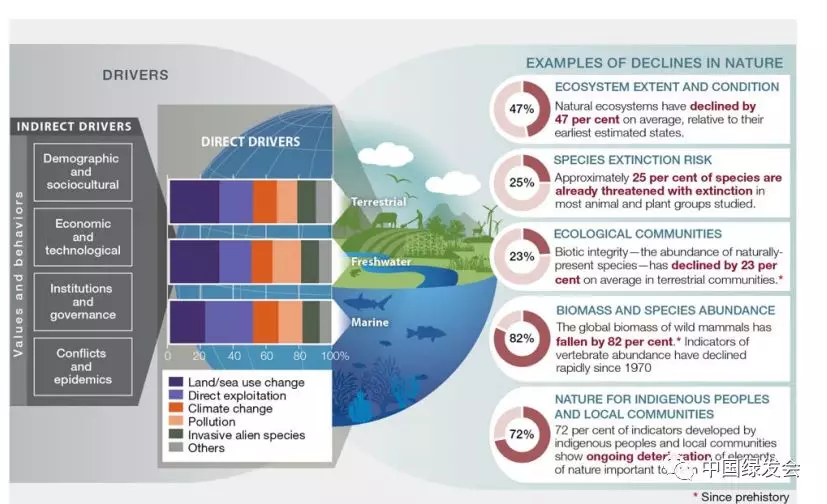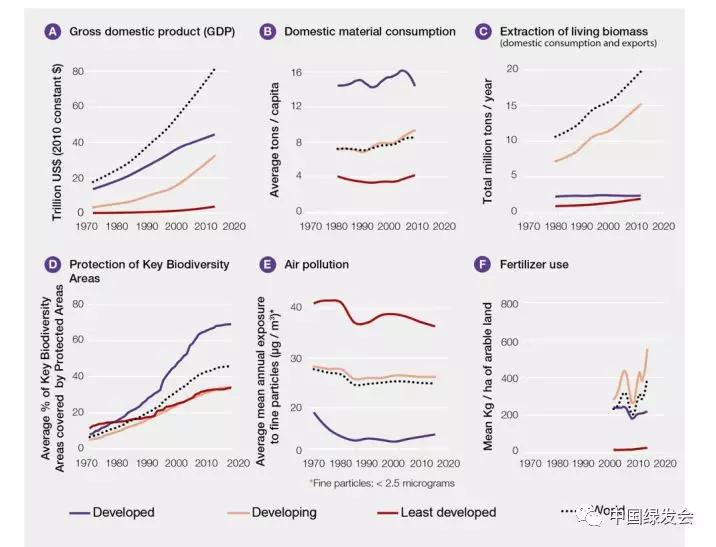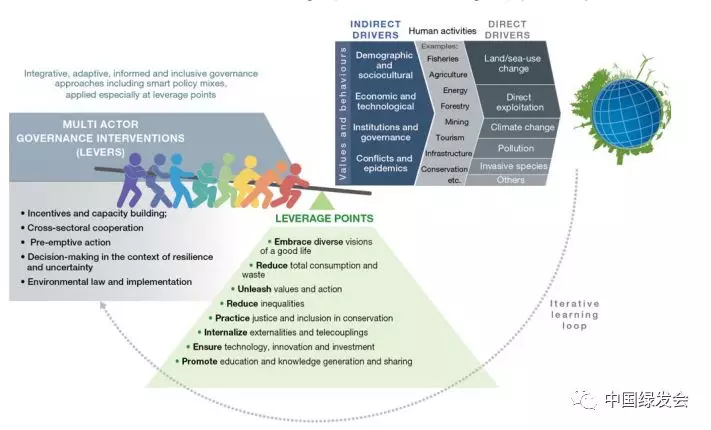政府间生物多样性和生态系统服务科学政策平台(IPBES)于5月6日发布了首个政府间的报告,这是2005年发表千年生态系统评估后的第一份政府间报告,该报告由132个政府的代表审议批准。
该报告将综合概述世界在实现可持续发展目标(SDGs)、爱知生物多样性目标和《巴黎协定》等重要目标的状态。它研究了生物多样性和生态系统变化的原因、其对人类的影响、政策选择以及如果当前趋势继续下去,未来30年可能的未来发展,以及其他情景。现绿会特此分享报告相关信息,以飨读者。
数字——报告中的关键数据和事实
By the Numbers – Key Statistics and Facts from the Report
总述
General
75%:迄今为止,受人类活动受到“严重改变”的陆地环境比例(海洋环境40%)?
75%: terrestrial environment “severely altered” to date by human actions (marine environments 40%)
47%:相对于其估计的自然基线,衡量全球生态系统范围和状况的指标减少,许多指标每十年至少继续下降4%?
47%: reduction in global indicators of ecosystem extent and condition against their estimated natural baselines, with many continuing to decline by at least 4% per decade

全球自然减少的例子,强调了生物多样性的减少都是由直接和间接的变化驱动因素造成的。(来源:IPBES)

1970年以来选定的人类环境关键指标的发展路径表明,全球经济增长规模及其对自然的影响显著扩大,在发达国家、发展中国家和最不发达国家中形成了鲜明的对比。(来源:IPBES)

全球可持续发展道路的变革方法(来源:IPBES)
28%:由土著居民持有和/或管理的全球土地面积比例,包括40%以上的正式保护区和37%人类干预非常低的剩余陆地面积?
28%: global land area held and/or managed by Indigenous Peoples, including >40% of formally protected areas and 37% of all remaining terrestrial areas with very low human intervention
+/-600亿:全球每年开采的可再生和不可再生资源吨数,自1980年以来增长了近100%?
+/-60 billion: tons of renewable and non-renewable resources extracted globally each year, up nearly 100% since 1980
15%:自1980年以来全球材料人均消费量增加率
15%: increase in global per capita consumption of materials since 1980
>85%:1700年的湿地在2000年已经消失的湿地比例——目前湿地的消失速度是森林消失速度的三倍,以百分比计算?
>85%: of wetlands present in 1700 had been lost by 2000 – loss of wetlands is currently three times faster, in percentage terms, than forest loss.
动植物种类?种群和品种
Species, Populations and Varieties of Plants and Animals
800万:地球上动植物物种估计总数(包括550万昆虫物种)
8 million: total estimated number of animal and plant species on Earth (including 5.5 million insect species)
数十到数百倍:当前全球物种灭绝率高于过去1000万年的平均水平,而且这一速度正在加速?
Tens to hundreds of times: the extent to which the current rate of global species extinction is higher compared to average over the last 10 million years, and the rate is accelerating
高达100万:濒临灭绝的物种数量,很多在几十年内灭绝?
Up to 1 million: species threatened with extinction, many within decades
>500000(+/-9%):世界估计590万陆生物种中,生活在由于没有修复,无法提供长期生存条件的栖息地的物种比例
>500,000 (+/-9%): share of the world’s estimated 5.9 million terrestrial species with insufficient habitat for long term survival without habitat restoration
>40%:濒临灭绝的两栖动物物种比例
>40%: amphibian species threatened with extinction
几乎33%:造礁珊瑚?鲨鱼和鲨属濒临灭绝占比,超过33%海洋哺乳动物濒临灭绝
Almost 33%: reef forming corals, sharks and shark relatives, and >33% marine mammals threatened with extinction
25%:(已受详细研究的)陆生?淡水和海洋脊椎动物?无脊椎动物和植物群面临灭绝威胁的物种的平均比例
25%: average proportion of species threatened with extinction across terrestrial, freshwater and marine vertebrate, invertebrate and plant groups that have been studied in sufficient detail
至少680种:16世纪以来人类活动导致脊椎动物物种灭绝的数量
At least 680: vertebrate species driven to extinction by human actions since the 16th century
+/-10%:濒临灭绝的昆虫物种的初步预估占比
+/-10%: tentative estimate of proportion of insect species threatened with extinction
>20%:自1900年以来,大多数主要陆地生物群落中本地物种的平均丰度下降率?
>20%: decline in average abundance of native species in most major terrestrial biomes, mostly since 1900
+/-560(+-10%):到2016年,驯养的哺乳动物品种灭绝数量,现至少还有1000种受到威胁?
+/-560 (+/-10%): domesticated breeds of mammals were extinct by 2016, with at least 1,000 more threatened
3.5%:到2016年家养鸟类品种的灭绝比例
3.5%: domesticated breed of birds extinct by 2016
70%:自1970年以来,21个国家入侵外来物种数量增加率,且有详细记录?
70%: increase since 1970 in numbers of invasive alien species across 21 countries with detailed records
30%:栖息地丧失和退化导致全球陆地栖息地完整性下降率
30%: reduction in global terrestrial habitat integrity caused by habitat loss and deterioration
47%:陆地上不能飞行的哺乳动物的比例和23%的受威胁鸟类,它们的分布可能已经受到气候变化的负面影响?
47%: proportion of terrestrial flightless mammals and 23% of threatened birds whose distributions may have been negatively impacted by climate change already
>6:有蹄类动物(有蹄类哺乳动物)可能会灭绝,或在没有保护措施的情况下仅在圈养中生存?
>6: species of ungulate (hoofed mammals) would likely be extinct or surviving only in captivity today without conservation measures
食品和农业
Food and Agriculture
300%:1970年以来粮食作物产量增加率
300%: increase in food crop production since 1970
23%:由于土地退化导致农业生产力下降的土地区域占比
23%: land areas that have seen a reduction in agricultural productivity due to land degradation
>75%:依赖动物授粉的全球粮食作物类型占比
>75%: global food crop types that rely on animal pollination
2350至5770亿美元:全球作物产量因授粉者减少而面临损失风险的年度价值
US$235 to US$577 billion: annual value of global crop output at risk due to pollinator loss
560亿吨:海洋和陆地生态系统中每年的二氧化碳排放量,相当于全球化石燃料排放量的60%
5.6 gigatons: annual CO2 emissions sequestered in marine and terrestrial ecosystems – equivalent to 60% of global fossil fuel emission
+/-11%:全球营养不良人口
+/-11%: world population that is undernourished
1亿:从1980年到2000年,热带地区的农业扩张面积(公顷)?主要是拉丁美洲的牧场(+/-4200万公顷),东南亚的种植园(+/-750万公顷,其中80%是油棕),一半是以原始森林为代价的?
100 million: hectares of agricultural expansion in the tropics from 1980 to 2000, mainly cattle ranching in Latin America (+/-42 million ha), and plantations in Southeast Asia (+/-7.5 million ha, of which 80% is oil palm), half of it at the expense of intact forests
3%:1992年至2015年期间,土地向农业的转化增加率,一半转化以牺牲完整的热带森林为代价?
3%: increase in land transformation to agriculture between 1992 and 2015, half at the expense of intact tropical forests
>33%:用于农作物或牲畜生产的世界陆地表面比例(和淡水资源的+/-75%)?
>33%: world’s land surface (and +/-75% of freshwater resources) devoted to crop or livestock production
12%:世界上用于农作物生产的不冻土地
12%: world’s ice-free land used for crop production
25%:世界上用于放牧的不冻土地(+/-70%的旱地)
25%: world’s ice-free land used for grazing (+/-70% of drylands)
+/-25%:土地清理?作物生产和施肥造成的温室气体排放,动物类食品占75%?
+/-25%: greenhouse gas emissions caused by land clearing, crop production and fertilization, with animal-based food contributing 75% to that figure
+/-30%:全球作物生产和全球粮食由小型土地控股公司供应(<2公顷),使用+/-25%的农业土地,通常利于保持丰富的农业生物多样性?
+/-30%: global crop production and global food supply provided by small land holdings (<2 ha), using +/-25% of agricultural land, usually maintaining rich agrobiodiversity
1000亿美元:经合组织国家对潜在对环境有害的农业的财政支持预估水平(2015年)
$100 billion: estimated level of financial support in OECD countries (2015) to agriculture that is potentially harmful to the environment
海洋与渔业
Oceans and Fishing
33%:2015年,海洋鱼类的捕捞量处于不可持续水平;60%的鱼类的捕捞量最大化;7%的鱼类的捕捞量不足?
33%: marine fish stocks in 2015 being harvested at unsustainable levels; 60% are maximally sustainably fished; 7% are underfished
>55%:工业捕鱼覆盖的海域
>55%: ocean area covered by industrial fishing
3-10%:仅在本世纪末,由于气候变化,预计海洋净初级生产量将减少?
3-10%: projected decrease in ocean net primary production due to climate change alone by the end of the century
3-25%:本世纪末,在低气候变暖和高气候变暖情况下,鱼类生物量预计分别减少?
3-25%: projected decrease in fish biomass by the end of the century in low and high climate warming scenarios, respectively
>90%:小规模渔业(超过3000万人)占全球商业渔民的比例——占全球鱼类捕获量的近50%?
>90%: proportion of the global commercial fishers accounted for by small scale fisheries (over 30 million people) – representing nearly 50% of global fish catch
高达33%:2011年全球报告的非法?未报告或不受管制的鱼类捕获量的估计比例
Up to 33%: estimated share in 2011 of world’s reported fish catch that is illegal, unreported or unregulated
>10%:1970-2000年海草草地面积每十年减少一次
>10%: decrease per decade in the extent of seagrass meadows from 1970-2000
+/-50%:自19世纪70年代以来消失的珊瑚礁的活珊瑚覆盖层占比
+/-50%: live coral cover of reefs lost since 1870s
1-3亿:沿海地区的人们由于失去海岸栖息地保护而面临更大的风险
100-300 million: people in coastal areas at increased risk due to loss of coastal habitat protection
400:由肥料引起的低氧(缺氧)沿海生态系统“死区”数量,影响范围>245000 km2
400: low oxygen (hypoxic) coastal ecosystem ‘dead zones’ caused by fertilizers, affecting >245,000 km2
29%:由于1996年至2008年的保护投资,109个国家的哺乳动物和鸟类的平均灭绝风险降低的比率;近十年如果不采取保护行动,鸟类?哺乳动物和两栖动物的灭绝风险至少会增加20%?
29%: average reduction in the extinction risk for mammals and birds in 109 countries thanks to conservation investments from 1996 to 2008; the extinction risk of birds, mammals and amphibians would have been at least 20% greater without conservation action in recent decade
>107:据估计,从岛上根除入侵哺乳动物中受益的高度濒危的鸟类?哺乳动物和爬行动物数量?
>107: highly threatened birds, mammals and reptiles estimated to have benefitted from the eradication of invasive mammals on islands
森林
Forests
45%:1970年以来原木材产量增加比例(2017年增加40亿立方米)
45%: increase in raw timber production since 1970 (4 billion cubic meters in 2017)
+/-1300万:林业行业的就业岗位数量
+/-13 million: forestry industry jobs
50%:以牺牲森林为代价的农业扩张率
50%: agricultural expansion that occurred at the expense of forests
50%:自20世纪90年代以来森林净损失率下降占比(不包括为木材或农业开采管理的森林净损失率)
50%: decrease in net rate of forest loss since the 1990s (excluding those managed for timber or agricultural extraction)
68%:与工业化前的估计水平相比,今天的全球森林面积占比
68%: global forest area today compared with the estimated pre-industrial level
7%:从2000-2013年,发达国家和发展中国家的原始森林减少占比(500平方公里以上,无人类压力)
7%: reduction of intact forests (>500 sq. km with no human pressure) from 2000-2013 in developed and developing countries
2.9亿公顷(+/-6%):1990-2015年因清理和砍伐木材而损失的原生森林覆盖量
290 million ha (+/-6%): native forest cover lost from 1990-2015 due to clearing and wood harvesting
1.1亿公顷:1990-2015年种植森林的增加面积
110 million ha: rise in the area of planted forests from 1990-2015
10-15%:非法林业提供的全球木材供应比例(某些地区高达50%)?
10-15%: global timber supplies provided by illegal forestry (up to 50% in some areas)
>20亿:依靠木材燃料满足初级能源需求的人数
>2 billion: people who rely on wood fuel to meet their primary energy needs
采矿和能源
Mining and Energy
<1%:采矿用地总量,但工业对生物多样性?排放?水质和人类健康有重大负面影响?
<1%: total land used for mining, but the industry has significant negative impacts on biodiversity, emissions, water quality and human health
+/-17000:大型采矿场(在171个国家)数量,主要由616家国际公司管理?
+/-17,000: large-scale mining sites (in 171 countries), mostly managed by 616 international corporations
+/-6500:海上石油和天然气海洋采矿设施(在53个国家)
+/-6,500: offshore oil and gas ocean mining installations ((in 53 countries)
3450亿美元:全球化石燃料补贴金额,导致5万亿美元的总花费,包括自然恶化的外部性因素;煤炭占税后补贴的52%,石油占+/-33%,天然气占+/-10%?
US$345 billion: global subsidies for fossil fuels resulting in US$5 trillion in overall costs, including nature deterioration externalities; coal accounts for 52% of post-tax subsidies, petroleum for +/-33% and natural gas for +/-10%
城市化?发展与社会经济问题
Urbanization, Development and Socioeconomic Issues
>100%:1992年以来城市地区的增长率
>100%: growth of urban areas since 1992
2500万公里:预计到2050年新铺设的道路长度,90%的建设将在最不发达国家和发展中国家进行?
25 million km: length of new paved roads foreseen by 2050, with 90% of construction in least developed and developing countries
+/-50000:大坝数量(>15m高);+/-1700万水库(>0.01公顷)
+/-50,000: number of large dams (>15m height); +/-17 million reservoirs (>0.01 ha)
105%:自1970年以来,各个国家和地区全球人口(从37亿增加到76亿)的不均衡增长率
105%: increase in global human population (from 3.7 to 7.6 billion) since 1970 unevenly across countries and regions
高出50倍:发达国家和最不发达国家的人均GDP
50 times higher: per capita GDP in developed vs. least developed countries
>2500:全球目前正在发生的化石燃料?水?食物和土地的冲突事件
>2,500: conflicts over fossil fuels, water, food and land currently occurring worldwide
>1000:环境活动家和记者在2002年至2013年间的死亡人数
>1,000: environmental activists and journalists killed between 2002 and 2013
健康
Health
70%:受自然启发研发的天然或合成的癌症药物比例
70%: proportion of cancer drugs that are natural or synthetic products inspired by nature
+/-40亿:主要依赖天然药物的人数
+/-4 billion: people who rely primarily on natural medicines
17%:由动物媒介传播的疾病占比,每年造成70万以上人类的死亡?
17%: infectious diseases spread by animal vectors, causing >700,000 annual deaths
+/-8.21亿:亚洲和非洲人民面临粮食安全问题
+/-821 million: people face food insecurity in Asia and Africa
40%:全球人口中缺乏清洁和安全饮用水的占比
40%: of the global population lacks access to clean and safe drinking water
>80%:未经处理排放的全球废水
>80%: global wastewater discharged untreated into the environment
3-4亿吨:每年工业设施倾倒到世界水域的重金属?溶剂?有毒污泥和的产生的其他废物的重量
300-400 million tons: heavy metals, solvents, toxic sludge, and other wastes from industrial facilities dumped annually into the world’s waters
10倍:1980年以来塑料污染增加
10 times: increase in plastic pollution since 1980
气候变化
Climate Change
1摄氏度:与工业化前相比,2017年全球平均温差;温差每十年上升+/-0.2(+/-0.1)摄氏度
1 degree Celsius: average global temperature difference in 2017 compared to pre-industrial levels, rising +/-0.2 (+/-0.1) degrees Celsius per decade
>3 mm:过去20年全球平均海平面每年上升水平
>3 mm: annual average global sea level rise over the past two decades
16-21厘米:1900年以来全球平均海平面上升水平
16-21 cm: rise in global average sea level since 1900
自1980年以来,温室气体排放量增加了100%,全球平均温度至少提高了0.7度?
100% increase since 1980 in greenhouse gas emissions, raising average global temperature by at least 0.7 degree
40%:2009年至2013年,旅游业的碳足迹增加率(达到4.5 Gt二氧化碳)
40%: rise in carbon footprint of tourism (to 4.5Gt of carbon dioxide) from 2009 to 2013
8%:温室气体排放总量中有8%来自与旅游有关的交通和食品消费?
8%: of total greenhouse gas emissions are from transport and food consumption related to tourism
5%:仅2°C的升温预计导致的部分物种灭绝比例;到4.3°C 物种灭绝比例增加至16%
5%: estimated fraction of species at risk of extinction from 2°C warming alone, rising to 16% at 4.3°C warming
即使全球变暖只上升1.5至2度,大多数陆地物种的分布范围预计将大幅缩小?
Even for global warming of 1.5 to 2 degrees, the majority of terrestrial species ranges are projected to shrink profoundly.
全球目标
Global Goals
大多数:2020年爱知生物多样性目标可能无法实现
Most: Aichi Biodiversity Targets for 2020 likely to be missed
44个目标中的22个:与贫穷?饥饿?卫生?水源?城市?气候?海洋和土地有关的可持续发展目标下的评估目标,正在被自然的负面趋势及人类的行为所破坏?
22 of 44: assessed targets under the Sustainable Development Goals related to poverty, hunger, health, water, cities, climate, ocean and land are being undermined by substantial negative trends in nature and its contributions to people
72%:土著居民和当地社区开发和使用的自然指标呈负面趋势
72%: of local indicators in nature developed and used by Indigenous Peoples and Local Communities that show negative trends
4:爱知目标的数量,其中某些部分取得了良好进展,另外7个目标的某些部分取得了适度进展,6个目标的所有内容进展缓慢,由于信息不足,无法评估其余3个目标的部分或所有部分的进展?
4: number of Aichi Targets where good progress has been made on certain components, with moderate progress on some components of another 7 targets, poor progress on all components of 6 targets, and insufficient information to assess progress on some or all components of the remaining 3 targets
来源:
https://mailchi.mp/ipbes.net/ipbes7-spm-media-2303437?e=06b7d45979
译/雪儿 审/Cat 编/Angel
【推 荐 阅 读】
IPBES报告关键议题 | 自然损失规模剧增,爱知目标和2030年可持续发展议程恐无法按期完成
地球良方终于开出——#IPBES7“全球评估”隆重出炉 | 绿会与全球同仁携手照方抓药
100万种物种濒临灭绝!绿会翻译分享:IPBES重磅评估报告通讯稿
绿会致力于减少生物多样性丧失,密切关注#IPBES7大会和正式发布的“全球评估”
终极预告 | 世界瞩目#IPBES7“全球评估”将于明日隆重发布,敬请密切关注
杜晖贤与CBD执行秘书Palmer博士会面,各界代表对“全球评估”审议只争朝夕 | #IPBES7巴黎大会正在进行时
周晋峰签署《全球自然保护协议》请愿书|生物多样性和生态系统服务政府间平台6日发布首份全球评估报告
CBD COP15引关注,绿会团与国际同仁切磋 | # IPBES7 巴黎大会正在进行时
世界对“全球评估”审议渐趋白热,绿会代表参与 | #IPBES7巴黎大会正在进行时
“走出去”传递“中国好声音” | 绿会代表巴黎大会开幕之际与IPBES执行秘书Anne Larigauderie博士会面


